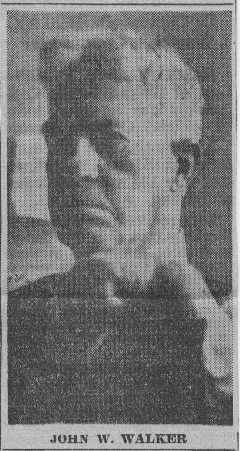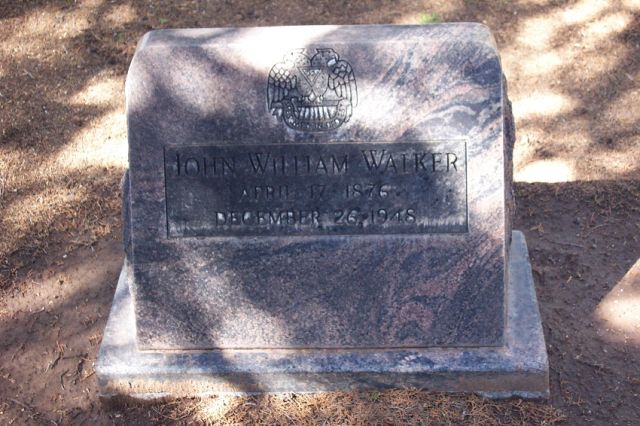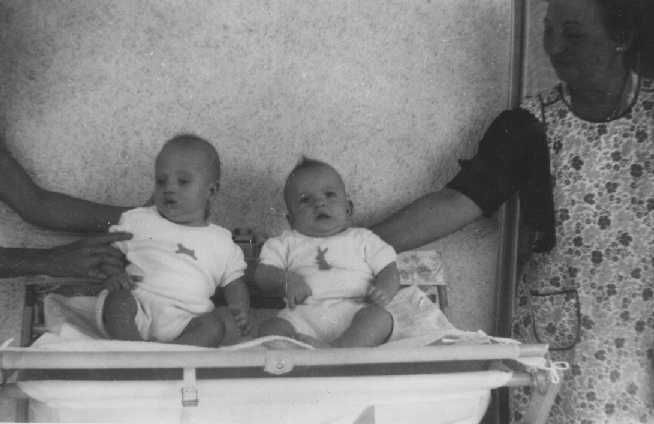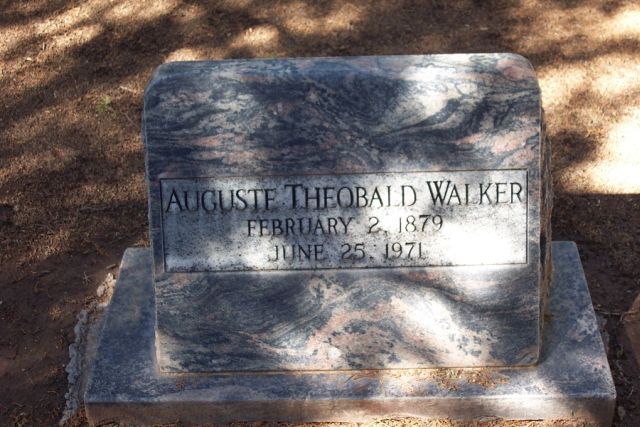John and Augusta Walker
My Walker family seems to include an unusual number of skilled
photographers. One of the earliest Walkers to take an interest in
photography was my great uncle, John William Walker. Although
he earned his living as the clerk of the United States District Court,
taking pictures was one of his great passions, going back to his
arrival in the Arizona Territory at the beginning of the 20th
century.1 The article below describes Uncle John as an "ardent camera
fan", but that's an understatement! To see what I mean, please take a
look at John Walker's Tombstone scrapbook.
This excellent biography appeared in the 18 August 1946 issue of the Tucson Daily Star:
WALKER, FEDERAL COURT CLERK,
RECALLS EARLY DAYS IN STATE
By Arnott K. Duncan
"Hear ye, hear ye, hear ye! This honorable United States
District Court for the District of Arizona is now in session."
Since 1903 that call, with variations, has been ringing in the
ears of John W. Walker, 1009 East Speedway.
And conditions in the courts, except for the changes in
statutory law and those caused by the switch from territorial
to statehood status, are much the same, then as now, according
to Walker, who came to Tombstone as the clerk for the federal and county court held there under the old territorial set-up.
Of course the old judges under the territorial government
acted both as federal and county judges, Walker explained,
having two sets of bailiffs and criers, and both a sheriff and
marshal working for them. The clerk doubled in both courts, he added.
The crier for the federal court would open the calendar
each morning, business for that court was taken care of, and
then the county crier would take over for the same judge and
county cases would be adjudicated. When the judges held court
in other than their home county -- each had several counties
for a territory -- they acted only in the county capacity.
Federal court was held only in the home county.
Met Periodically
At that time there were five such judges in the state, Walker
reminisced -- at Tombstone, Tucson, Globe, Phoenix and Prescott.
They met periodically as the territory supreme court, the judge
whose case was being reviewed dropping out temporarily.
The winter session of the old territorial supreme court was
the cause of a very fancy social season in Phoenix, he said with
a smile, because of the presence there of the court with its
attendant attorneys and litigants.
Walker served as clerk in Tombstone under Fletcher M. Doan,
Fred A. Sutter and Alfred C. Lockwood who later became state
supreme court chief justice. He considers that Doan was an outstanding man.
In 1918 he moved to Tucson where he served as clerk under U. S.
District Court Judge William H. Sawtelle until 1930, then under
Judge Albert M. Sames until this year when Judge Sames retired.
He is now secretary for Judge Howard C. Speakman. Admitted to the
federal bar, he was for four years assistant U. S. Attorney in
the early 1920's when Judge Sawtelle presided. Judge Sawtelle
left in 1930 to accept a position on the bench of the Ninth
Circuit Court of Appeals.
Once Studied Law
The white thatched secretary who still likes to roll his own
cigarettes studied law at the University of Indiana during the
gay 90's, but failed to finish and receive his degree. Later he
worked for four years in a law office in eastern Indiana and was
for a time law clerk for three Indiana counties, having an office
over the building in Crown Point
where Dillinger later escaped.
Newton county -- George Ade's home county -- was one of the three.
Later he worked as a law clerk for a railroad company in Chicago,
quitting to come to Arizona. Asked if he didn't know more law than
many of the lawyers with degrees admitted to the state bar, he
chuckled and said, "That wouldn't mean much. Many lawyers know very
little law."
Although things were not as exciting in Tombstone when he got
there as they had been in the days when the Earps were knocking
off the Clantons and their buddies,2 Walker said that Tombstone's
600 to 800 miners made it a pretty busy little town.
He was there when the ordinance came out barring the presence of
women in the saloons, many of which had dancing girls, and later
when the state laws came out stopping the open gambling and
prohibiting the sale of liquor. Arizona's prohibition came two
years before the national Eighteenth Amendment, he recalls. He
considers these three periods as outstanding among interesting
times in Arizona law enforcement.
Silver Mines Flooded
Things quieted down pretty well in the "town too tough to die"
when water flooded the silver mines up to the 1,000-foot level.
A carload of oil a day had been used supplying the giant pumps on
the 1,000-foot level before the owners finally gave up, he
remembers. After the pumps shut down, the water came up over
them within an hour. The run-off of millions of gallons of water
a day from the pumps kept many small truck gardens and orchards
going in those days. One man with about half a block of farm land
sold $10 worth of tomatoes a day. And $10 in those days was real
money in Tombstone.
Walker seldom goes back to Cochise County any more, most of
his friends having left or died.
An ardent camera fan, he tried to get a picture of the halting
of the pumps in the mine, but dripping water spoiled the early
flash equipment he had.
He has thousands of negatives, some dating back before the
turn of the century. He still has what he considers the poor ones
taken in the mine. Taking pictures is his "greatest dissipation
-- not my only one", he said, "but my greatest one."
He gives away most of the prints he makes in his own dark room
"in the basement among the rats", but has negatives even from his
Indian days and taken all over the U. S., Canada and Mexico.
Photographs Cacti
He is proudest of one of the world's largest collections of
cactus photographs, many with beautiful cloud backgrounds.
He considers a love of unsweetened black coffee another
dissipation. A hard and industrious worker, he relaxes Saturday
afternoons and every Saturday at 5 p.m. his wife makes him a pot
of coffee. He says he is no connoisseur, however.
In 1924 he married Mrs. Augusta Orbaugh in Florence. His
stepson, H. T. Orbaugh, who graduated from the University of
Arizona in the late 1920's, a head mechanical engineer for the
York Ice Machine Corporation with headquarters in Seattle, Wash.
At present he is in Alaska for a month to install refrigeration
plants for salmon packers.
With Judge Speakman, Walker will leave Tucson about August
28 for the coast where they will attend a meeting of district
judges beginning September 2. After the meeting Judge Speakman,
accompanied by Walker, will take the bench in the district court
in Seattle until the latter part of October.
The Tucson Daily Citizen also mentioned John's Seattle trip on page 3 of its 6 Aug 1946 edition:
Speakman To Preside In Seattle Court
U. S. District Judge Howard C. Speakman will leave Tucson late
in August to attend the conference of Federal judges in San
Francisco beginning Sept. 2, and to preside in the district court
in Seattle during the month of September and part of October, it
was announced yesterday.
Judge Speakman has been assigned to Seattle in order to help
out with an unusually crowded court calendar in that city at a
time when there is little on the docket in Tucson, he said.
He will be accompanied by his secretary, John W. Walker.
These news items indicate that John Walker remained active in his judicial duties until shortly before his death, which was reported in articles in the 27 Dec 1948 issues of the Arizona Daily Star, the Tucson Daily Citizen (front page), and in a third undated article:
COURT CLERK TAKEN IN DEATH
John W. Walker Dies Here At East Speedway Home; Served for 29 Years
John W. Walker, 72, U. S. District Court clerk in Tucson for 29 years, died yesterday at his home, 1009 East Speedway.

Mr. Walker is survived by his Wife, Mrs. Auguste Walker, and a Step-son, H. T. Orebaugh, of Seattle, Wash.
He was born and attended schools in Bloomington, Ind., entering the University of Indiana in 1895, where he studied law until 1897. He then studied shorthand reporting in Washington, D. C.
Mr. Walker's court career began in Winchester, Ind, where he was unofficial court reporter. He became official reporter at Rennsselaer, Ind., in 1899. In 1900 he was admitted to the Indiana state bar, and also admitted to practice before the state supreme court.
To State In 1903
He came to Arizona in 1903 and was appointed official reporter for the territorial court at Tombstone. He resigned In 1918.
In Tucson he became clerk under U. S. District Court Judge William H. Sawtelle. He served also under Judge Albert M. Sames, and finally under Judge Howard C. Speakman. He retired March 31 1947.
He was a member of all lodges affiliated with the Free and Accepted Masons. Funeral arrangements under the direction of the Masons, will be announced later by the Parker mortuary.
Retired Court Clerk Expires
Funeral arrangements will be announced by the Parker mortuary for John W. Walker, 72, former U. S. district court clerk in Tucson who died Sunday at his home, 1009 East Speedway. He had held that position for 29 years.
Born and educated in Bloomington, Ind., Mr. Walker attended law school at the University of Indiana until 1897, when he began to study shorthand reporting in Washington, D. C. He was unofficial court reporter in Winchester, Ind., becoming official reporter at Rensselaer, Ind., in 1899.
He was admitted to the Indiana state bar in 1900 and was also admitted to practice before the state supreme court.
Coming to Arizona in 1903, Mr. Walker was appointed official reporter for the territorial court at Tombstone, resigning in 1918. He served as clerk of the U. S. district court in Tucson under Judges William H. Sawtelle, Albert M. Sames and Howard C. Speakman. He retired Mar. 31, 1947.
Survivors are his wife, Mrs. Auguste Walker, and a stepson, H. T. Orebaugh, Seattle. Mr. Walker was a member of all lodges affiliated with the Free and Accepted Masons.
JOHN W. WALKER
Funeral services will be held at two o'clock this afternoon in the Parker mortuary chapel for John W. Walker, 72, of 1009 East Speedway, who died Sunday. Rev. Willard A. Schurr, of the First Methodist church, will officiate.
Burial will be in the Masonic plot of Evergreen cemetery, with Tucson Lodge No. 4, F. and A. M., officiating. Pallbearers are Oliver P. Lindsay, John Burke, Leslie Clawson, H. P. Orebaugh, John Epley, David H. Carey, and Paul Sisk.
Mr. Walker had been court reporter in Arizona territorial and disrict courts for 44 years when he retired in 1947. For 29 years he was law-clerk and reporter for the U.S. district Court in Tucson.

John Walker married Mary Elizabeth "May" Chamberlain 5 Apr 1913 in Cochise County, Arizona. According to their marriage record, May was born in 1883 in Indiana. Like John, she was a court reporter, or stenographer, and in the 1910 census, she and John were enumerated in Tombstone, one page away from each other, each as a "roomer" in a different household. In the 1920 census, they were enumerated together in Tucson.
Aunt Augusta
After being divorced from May, Uncle John married Mrs. Augusta (Theobald) Orebaugh in 1924. Aunt Augusta was born 2 Feb 1879 in Columbus, Ohio, to Frederick and Clara Theobald, with whom she was enumerated in Columbus in the 1880 census. Augusta grew up in Columbus' German Village. Her father was an immigrant from Bavaria and her mother was probably also of German descent. Although we knew her as Augusta, her name was often spelled Auguste, including on her grave marker (see below).
Some time after 1900, Augusta married Earle Orebaugh and had one child with him, Howard T. Orebaugh, born 19 Mar 1903.3 She moved to Seattle with Earle and their son, who was known as Theo. Between their arrival in Seattle and 1910, Augusta and Earle were divorced and Earle married a woman named Edith, or Edythe. We could find no trace of Augusta or Theo in the 1910 or 1920 censuses. In 1930, Theo was working as a draftsman in Seattle, living in a boarding house on Terry Avenue. My parents traveled occasionally to Seattle during the 1950s and '60s, and mentioned visiting Theo and his family there. He died in Seattle in March 1974.3
While I lived in Tucson with my parents, John and Augusta Walker were living in a spacious brick house at 1009 East Speedway. John had designed it himself and it had a large basement which he used for his darkroom. The house seemed to stay fairly comfortable during the Arizona summer without the benefit of air conditioning. John and Augusta were enumerated there in the 1930 census, which listed the house's value at $10,000. At that time, my mom's good friend, Kathryn Kinney, was living at 1027 E. Speedway with her parents Jack and Alice. The Kinneys' home was valued at $15,000, while the tiny house across the alley at 1124 N. Park Avenue, which Mom and Dad rented during World War II, was occupied by its owners, the Newman family, and was valued at $5,000.
In 1940, for whatever reason, John and Augusta weren't enumerated in the census, although other people who lived in their block on Speedway did get counted, including the Kinneys at 1027 with the little boy who became my best friend and playmate, John D. "Binky" Barkley. And our future home around the corner wasn't listed either.
After we moved in on Park Avenue in May 1942, I can remember spending a lot of time visiting John and Augusta and playing in their large back yard. Uncle John liked to "roll his own" Bull Durham cigarettes. Aunt Augusta was very helpful to Mom after the arrival of my twin brothers:

Speaking of the twins, my brothers have vivid memories of Uncle John even though he died when they were only five years old. Brother John mentioned how he enjoyed driving out to Sabino Canyon with John and Augusta, over a dirt road and through streams which flowed across the road. He remembers the sun tea Augusta would make, and eating grapes in the grape arbors in their back yard, and also foraging in the garage for nails to pound into boards.
After John's death, Aunt Augusta continued to live on East Speedway. Her name appears in the Tucson newspapers occasionally in lists of real estate transactions. She liked to travel, visiting Theo and his family in Seattle, and going to southern California to visit her Walker relatives there. I can remember visiting her in Tucson with my parents, and later with my own family. In Tucson, we would go out to lunch or dinner with Augusta at Mexican restaurants such as Pancho's or El Charro.
The University of Arizona expanded north across Speedway, buying up entire city blocks of property. The block where we, the Kinneys, and John and Augusta Walker once lived is now a parking garage. The school at the corner of Park and Helen which I attended during my kindergarten and first grade years is now a student housing project. I don't know whether these developments occurred before, or after, Aunt Augusta moved to her final home:
WALKER, Augusta T., 92, of 150 S. Eastbourne passed away June 25.
Survived by son, Howard Orebaugh, of Seattle, Washington.
Arrangements pending by Adair Funeral Home, Dodge and Speedway.
Tucson Daily Citizen, 25 Jun 1971, page 34
WALKER, Augusta T., 92, of 150 S. Eastbourne passed away June 25.
Survived by son, Howard Orebaugh, of Seattle, Washington;
3 grandchildren; 6 great-grandchildren; sister Miss Hilda Theobald;
brother Erwin Theobald, both of Ohio. Services will be conducted
Wednesday 1:30 p.m. at the Adair Funeral Home. Reverend Everett
McDowell will officiate. Interment in Evergreen Cemetery. Friends
may call until service time Wednesday at the Adair Funeral Home,
Dodge and Speedway.
Tucson Daily Citizen, 29 Jun 1971, page 35
Like John, Augusta is buried in Block 18 at Evergreen cemetery. Note the spelling of her first name on her tombstone:

1 John Walker's move to Tombstone may have been the result of the previous arrival of another young man from Indiana,
Lee O. Woolery. Lee was already living in Tombstone at the time of the 1900 U. S. census. Although that census doesn't list his occupation, he was a lawyer who eventually found employment as the Assistant Cochise County Clerk. The two men may have known each other from Bloomington and frequently rubbed elbows in the courthouse in Tombstone. Although Leo wasn't related to John, he and I are descended from the same
Woolerys.
2 John Walker arrived about 22 years after the famous
gunfight at the OK Corral.
3 Theo's dates are taken from the Social Security Death Index. His middle name was quite likely
Theobald.
This page was last updated 27 Jun 2015.



